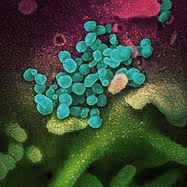Which impact for proton pump inhibitors in SARS-CoV-2 pneumonia

Submitted: February 14, 2021
Accepted: June 8, 2021
Published: October 19, 2021
Accepted: June 8, 2021
Abstract Views: 1201
PDF: 547
Publisher's note
All claims expressed in this article are solely those of the authors and do not necessarily represent those of their affiliated organizations, or those of the publisher, the editors and the reviewers. Any product that may be evaluated in this article or claim that may be made by its manufacturer is not guaranteed or endorsed by the publisher.
All claims expressed in this article are solely those of the authors and do not necessarily represent those of their affiliated organizations, or those of the publisher, the editors and the reviewers. Any product that may be evaluated in this article or claim that may be made by its manufacturer is not guaranteed or endorsed by the publisher.
Similar Articles
- Carlo Iadevaia, Fabio Perrotta, Grazia Mazzeo, Francesco Saverio Cerqua, Gennaro Mazzarella, Salvatore Guarino, Roberto Parrella, Andrea Bianco, Incidental diagnosis of lung adenocarcinoma following coronavirus OC 43 severe pneumonia , Monaldi Archives for Chest Disease: Vol. 90 No. 3 (2020)
- R.A. Stolarek, M. Kasielski, J. Rysz, P. Bialasiewicz, D. Nowak, Differential effect of cigarette smoking on hydrogen peroxide and thiobarbituric acid reactive substances exhaled in patients with community acquired pneumonia , Monaldi Archives for Chest Disease: Vol. 65 No. 1 (2006): Pulmonary series
- Matteo Vigna, Piero Ceriana, Mara Santomassimo, Michele Vitacca, Mauro Maniscalco, Nicolino Ambrosino, Effects of pulmonary rehabilitation in survivors of severe acute respiratory syndrome coronavirus 2. Role of vaccination , Monaldi Archives for Chest Disease: Vol. 94 No. 3 (2024)
- Alessandro Mezzani, Francesco Cacciatore, Raffaella Catanzaro, Alessandra Gualco, Daniela Guzzetti, Dario Leosco, Mauro Monelli, Franco Tarro Genta, Paolo Totaro, Egidio Traversi, Emanuela Zanelli, Pantaleo Giannuzzi, A multicenter, randomized, controlled trial on short-term feasibility and impact on functional capacity, symptoms and neurohumoral activation , Monaldi Archives for Chest Disease: Vol. 82 No. 1 (2014): Cardiac series
- F. Blasi, S. Aliberti, Pneumonia: how important are local epidemiology and smoking habits? , Monaldi Archives for Chest Disease: Vol. 65 No. 1 (2006): Pulmonary series
- R.M. Jones, A. Dawson, E.N. Evans, N.K. Harrison, Co-existence of organising pneumonia in a patient with Mycobacterium Avium Intracellulare pulmonary infection , Monaldi Archives for Chest Disease: Vol. 71 No. 2 (2009): Pulmonary series
- Sunny Kumar, Saurabh Mehra, Mrinal Sircar, Onkar Jha, Rajesh Gupta, Seema Sinha, Ravneet Kaur, Evaluation of the efficacy of convalescent plasma in moderate to severe COVID-19 during 2020-2021: a retrospective observational study , Monaldi Archives for Chest Disease: Early Access
- Megha Hegde, Saurav Raj, Dhananjay Tikadar, Sanatkumar B Nyamagoud, Unveiling vaccine safety: a narrative review of pharmacovigilance in India’s COVID-19 vaccination , Monaldi Archives for Chest Disease: Vol. 94 No. 4 (2024)
- G. Caramori, D. Artioli, G. Ferrara, R. Cazzuffi, C. Pasquini, M. Libanore, V. Guardigni, I. Guzzinati, M. Contoli, R. Rossi, R. Rinaldi, C. Contini, A. Papi, Severe pneumonia after intravesical BCG instillation in a patient with invasive bladder cancer: case report and literature review , Monaldi Archives for Chest Disease: Vol. 79 No. 1 (2013): Pulmonary series
- S.W. Yan, C.F. Wong, P.C. Wong, C.F. Cheung, Bronchiolitis Obliterans Organising Pneumonia (BOOP) in a lung cancer patient after lobectomy , Monaldi Archives for Chest Disease: Vol. 63 No. 1 (2005): Pulmonary series
<< < 1 2 3 4 5 6 7 8 9 10 > >>
You may also start an advanced similarity search for this article.

 https://doi.org/10.4081/monaldi.2021.1803
https://doi.org/10.4081/monaldi.2021.1803





